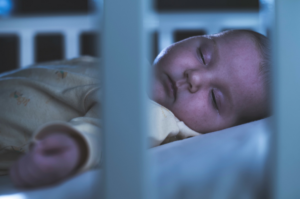Transitioning your baby from a bassinet to a regular crib is actually a bigger deal than most parents realize. It’s important to both your child’s safety and how well they sleep in the future!
 The ideal age to make the move is when your child turns four months old. This coincides with when we see the first big leap in gross motor development skills (such as rolling side to side, or all the way over onto their tummy, by themselves). When baby becomes mobile there are new safety concerns that are present, and we don’t want to wait for something potentially dangerous to happen before we act to protect them. We are now protecting them from harming themselves, and we must be — not one, but two steps — ahead of them (this is good practice for the teenage years!).
The ideal age to make the move is when your child turns four months old. This coincides with when we see the first big leap in gross motor development skills (such as rolling side to side, or all the way over onto their tummy, by themselves). When baby becomes mobile there are new safety concerns that are present, and we don’t want to wait for something potentially dangerous to happen before we act to protect them. We are now protecting them from harming themselves, and we must be — not one, but two steps — ahead of them (this is good practice for the teenage years!).
A bassinet or co-sleeper does not have sidewalls high enough to protect baby from falling out should they decide to pull or push themselves up high enough to where their little chin is at the same level as the top of the sidewall. Once that happens, because their heads are so much heavier than the rest of their body, they can go right over the edge. And because babies tend to discover, obsess over, and practice these exciting new skills in their sleep environment, which is also where there is less supervision, it must be the safest place in your home!
We must also remove mobiles. Baby is now learning to reach for and grab things. Another common safety hazard is baby monitors (and their cords) being mounted to crib railings or placed near enough where the cord can be reached by a young child. The crib mattress should be lowered, and free of bumpers, positioners, blankets, “lovies”, or stuffed animals. Nothing but a firm, tight mattress and a tight-fitting sheet should be in that crib with your sweet baby.
Four months old is also when a huge cognitive brain surge takes place, and the emergence of object permanence begins to develop. By ages five to six months, babies become more aware of, and attached to, their surroundings. They thrive on consistency and familiarity.
For that reason: Four months old is the ideal time to transition baby to what will become a more permanent sleep environment (ideally, a safe crib).
This can be accomplished either in parent’s bedroom for the remainder of his or her first year, as recommended by the American Academy of Pediatrics, or in an independent sleep environment in close proximity to parent’s bedroom, equipped with a proper video and audio baby monitor system.
You may make the transition gradually, if you like, by placing your baby in their new, safe crib for one or two naps a day, then all naps, and eventually night sleep. When baby is safe and sound, its sweet dreams for everyone!
——————
View original blog on Lullaby Earth:
——————
Jenni June Certified Child and Family Sleep Consultant, CLC and practitioner member of the National Sleep Foundation and the Breathe Institute in Los Angeles

